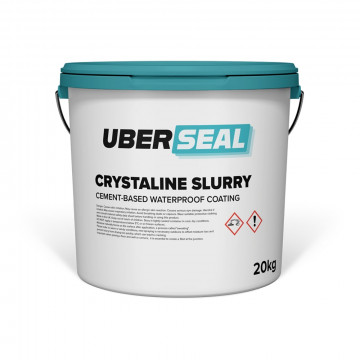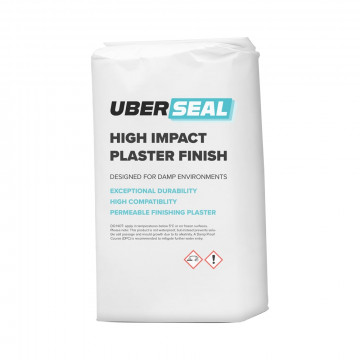UberSeal SBR Additive
UberSeal SBR additive delivers exceptional performance and reliability in a wide range of uses. Suitable for use as an SBR Primer, or as an admixture in SBR slurries and sand/cement renders. It significantly enhances adhesion, water resistance, flexibility, and durability of renders and slurries. This SBR bonding agent is ideal for both external and internal use in areas that may experience intermittent or continuous water exposure. It excels on dry substrates to minimize suction and is also effective on non-porous and extremely smooth substrates.
What is SBR?
SBR, short for Styrene Butadiene Rubber, is a water-resistant bonding and sealing agent that possesses many attributes similar to PVA. However, a crucial distinction is that unlike PVA, which remains water-soluble after drying, SBR gains water-resistant properties once it has dried, making it ideal in waterproofing projects in a wide variety of applications.
APPLICATIONS
- SBR Primer: acts as a primer on a variety of surfaces to enhance adhesion.
- SBR Slurry: improves adhesion and flexibility of cement-based mixes on low suction surfaces.
- SBR Render: adds to sand/cement renders to create dense, impermeable coatings in areas requiring water or chemical resistance.
- Bedding Mix: ideal for bonding tiles, kerb stones, coping stones, mosaics, and brick slips.
- Patching Mix: used for patching renders or concrete.
- Damp Proofing: employed as a slurry in basements to combat dampness seeping from behind plaster.
The many uses of UberSeal SBR Additive
SBR is incredibly versatile, having excellent adhesive and waterproofing properties, it can be used in a remarkable amount of ways when it comes to plastering, construction and waterproofing projects. Typically, it can be added to a mixture of cement, sand or water at varying ratios to provide a cementitious renders, screeds or patching mixes or even simply used as a primer to improve the bonding of tanking slurries or plaster.
SURFACE PREPARATION
Ensure all surfaces are clean, stable, and free of loose materials, dust, laitance, or old coatings, revealing the underlying brickwork, masonry, or concrete. If applicable, remove any embedded foreign objects such as nails or timber. Depending on the application, surfaces should either by dry or slightly damp with no standing water.
SBR Primer
Preparation
The most common use of SBR is as a primer, instead of PVA which can become porous when it dries, SBR dries as water-insoluble. When tacky, it improves the adhesion of whatever is used to coat it. To mix: one part SBR Additive should be added to three parts water.
Application
- Ensure all non-target surfaces are covered, and appropriate PPE is worn.
- SBR Primer can either be rolled on by brush, or applied using a pressure sprayer.
- Apply and leave to stand until tacky before proceeding with the application of tanking slurry, screed, etc
Please note: If applied with a pressure sprayer, ensure to completely clean the nozzle to prevent the primer from drying within the tube, rendering it unusable in the future.
SBR Slurry
Preparation
An SBR Slurry enhances the adhesion of cement-based mixes to low suction surfaces and is ideal for pre-treatment before applying SBR-modified mixes. Prepare the surface as previously described, but in this instance ensure to grit-blast the surface to create a mechanical key for better improved adherence. For high suction surfaces, dampen and prime with an SBR Primer mix to achieve a damp surface before applying the SBR slurry. If applied to the floor, there should be no standing water present.
To mix: The mix ratio is 1-part SBR:1-part Clean Water:5-Parts cement (by volume). Start by mixing together the required quantity of cement and sand. Once fully incorporated, add the SBR additive, mixing by hand for roughly 30 seconds. Once uniform, slowly add the water until a creamy consistency is reached. Please note: hand mixing is recommended to reduce the chance of excess air being introduced to the mix.
Application
- Vigorously brush the SBR slurry onto the surface using a stiff brush to achieve approximately 1mm thickness, ensuring complete coverage.
- Apply subsequent coatings, like render or top coat, while the bonding slurry is still wet.
- If the slurry dries out, apply an additional coat at right angles to the initial application.
SBR Render
Preparation
Incorporate SBR additive into renders to create dense, impermeable SBR renders suitable for areas needing water or chemical resistance. To mix: The mix ratio is 1-part OPC:4.5-parts soft washed sand:0.2-parts SBR:water as required (i.e. 5 litres of SBR Bonding Additive per 25kg of cement).
Application
- Apply render onto tacky primer, limiting the first coat to 7mm thickness.
- Scratch the surface and allow the first coat to set before proceeding.
- For enhanced protection, let the first coat cure overnight, then apply a second bonding coat.
- Apply the second coat of render, maintaining a similar thickness.
- Trowel or float the final coat to achieve a smooth finish.
- In severe drying conditions, keep the render damp for up to two days to ensure proper cement curing.
IMPORTANT INFORMATION
- Provided mixes serve as a guideline only and do not form a specification, owing to possible differences in materials and site conditions.
- Important: Avoid overmixing the bonding agent.
- Do not combine with other additives in the same gauging water.
- Please note: bonding agent is unsuitable for coloured renders because of its limited UV resistance, which can lead to discolouration.












